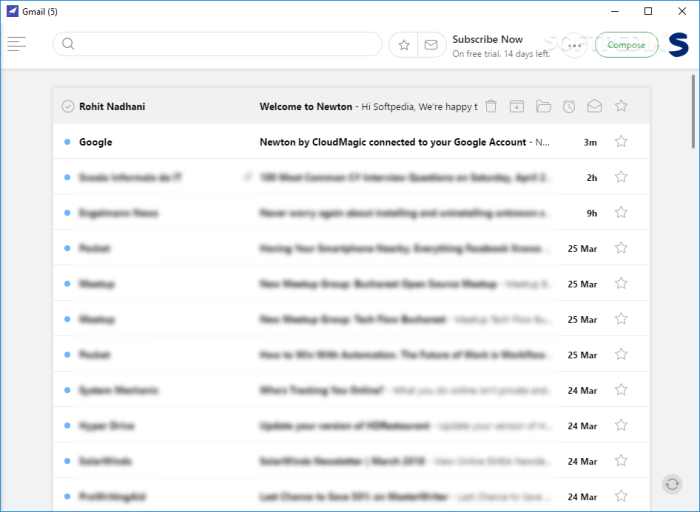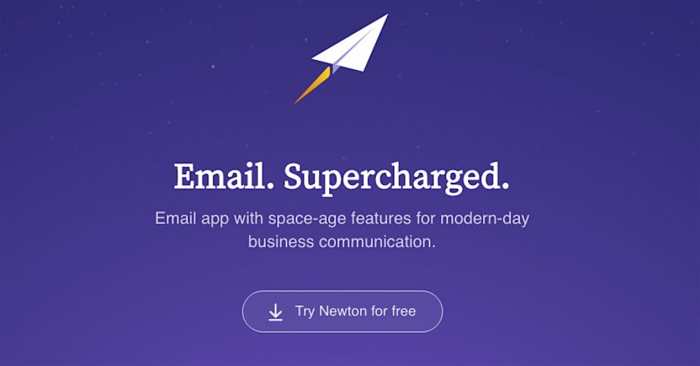Newton Mail makes a surprise return—a phoenix rising from the email ashes! Remember the sleek, privacy-focused email client that vanished years ago? Well, it’s back, and this isn’t your grandpappy’s inbox. This comeback is sparking conversations, raising questions about its long-term viability, and forcing us to reassess the ever-evolving email landscape. Get ready to dive into the story of Newton Mail’s unexpected resurrection.
From its initial launch and subsequent shutdown to the reasons behind its revival and the features that set it apart from competitors like Gmail and Outlook, we’ll explore every angle. We’ll dissect its new features, analyze its market position, and even peek into user feedback – both good and bad. Buckle up; it’s time to revisit the past and see what the future holds for this unexpected contender.
Historical Context of Newton Mail
The unexpected return of Newton Mail is a blast from the past for many email veterans. For those unfamiliar, Newton Mail wasn’t just another email client; it was a premium service aiming to redefine how we interacted with our inboxes. Its story, however, is one of both brilliance and bittersweet failure, a cautionary tale in the ever-evolving landscape of tech.
Newton Mail, launched in 2014 by CloudMagic, quickly gained a reputation for its sleek design and powerful features. It offered a clean interface, robust search capabilities, and smart integrations, making it a favorite among productivity-focused users. Its appeal lay in its attempt to move beyond the limitations of basic email clients, offering a more intelligent and streamlined experience. The service’s initial success was largely due to its focus on providing a superior user experience, something that many email providers at the time were neglecting.
Newton Mail’s Features Compared to Competitors
At its launch, Newton Mail stood out against competitors like Gmail, Outlook, and Yahoo Mail primarily through its focus on advanced features and a premium, paid model. While Gmail offered free storage and a wide array of features, it often felt cluttered and less refined. Outlook, while powerful, was more tied to the Microsoft ecosystem. Yahoo Mail, meanwhile, was increasingly viewed as a less sophisticated option. Newton Mail, in contrast, offered a minimalist yet powerful interface, prioritizing speed and efficiency. Key differentiators included its superior search functionality, its unified inbox for various email accounts, and its integration with other productivity apps. Upon its closure, these features were still considered cutting-edge by some, highlighting how ahead of its time Newton Mail truly was. The absence of a free tier, however, proved to be a significant obstacle to broader adoption.
Newton Mail’s Closure and Reasons
Despite its initial success, Newton Mail ultimately shut down in 2018. The primary reason cited was the unsustainable cost of providing its advanced features, particularly the integration with third-party services like calendar syncing and read receipts. These features, while highly desirable, were expensive to maintain, especially with a relatively small user base compared to giants like Google and Microsoft. The company struggled to balance its premium pricing model with the cost of these premium features, resulting in the difficult decision to cease operations. This illustrates the challenges faced by smaller companies attempting to compete in a market dominated by well-established players with immense resources.
Features and Functionality of the Relaunched Service: Newton Mail Makes A Surprise Return
Newton Mail’s surprise return isn’t just about nostalgia; it’s about a refined email experience built upon a solid foundation. The relaunched service boasts significant improvements over its predecessor, addressing past shortcomings and incorporating modern features expected in today’s competitive email landscape. This section delves into the specific features and functionalities, highlighting the evolution from the original Newton Mail to its current iteration.
Feature Comparison: Original vs. Relaunched Newton Mail
The following table directly compares the features of the original Newton Mail with the relaunched version, showcasing both continuities and significant upgrades. Note that some features may have been re-implemented with enhanced capabilities.
| Feature | Original Newton Mail | Relaunched Newton Mail | Differences |
|---|---|---|---|
| Email Client Interface | Clean, minimalist design; focused on core email functionality. | Modernized interface; likely incorporates responsive design for various devices. Potentially enhanced visual appeal and intuitive navigation. | Improved user interface design, likely with enhanced responsiveness and visual appeal. |
| Security Features | End-to-end encryption (possibly limited scope). | Enhanced security measures, likely including improved encryption protocols and data protection policies. Possibly two-factor authentication enhancements. | Strengthened security protocols and features for improved user data protection. |
| Third-Party Integrations | Limited integrations with other services (calendar, task management, etc.). | Expanded integration capabilities with popular productivity and collaboration tools. This might include calendar apps, task managers, cloud storage, and more. | Significantly expanded range of supported third-party applications for enhanced workflow integration. |
| Snooze Feature | Possibly absent or limited. | Likely included, allowing users to postpone notifications and manage inbox clutter effectively. | Addition of a valuable time management feature for improved inbox organization. |
| Push Notifications | Present, but potentially with limitations in reliability or customization. | Improved push notification system with customizable settings for frequency and notification types. | Enhanced reliability and customization of push notifications for improved responsiveness. |
| Mobile App Support | Likely supported on iOS and Android. | Continued and likely improved support for iOS and Android, potentially with updated UI/UX. | Continued mobile support with possible improvements to app design and functionality. |
New Features and Improvements, Newton mail makes a surprise return
The relaunched Newton Mail likely incorporates several new features designed to enhance user productivity and experience. These additions address modern email management needs and expectations. For example, the improved search functionality might utilize advanced algorithms to provide faster and more accurate results. The introduction of a unified inbox could streamline the management of multiple email accounts. Furthermore, enhanced customization options, such as themes and notification preferences, offer greater user control over the overall experience. The inclusion of a robust spam filter is also expected, minimizing unwanted emails and maintaining a clean inbox.
User Interface and User Experience Differences
The updated user interface is likely to feature a more modern and intuitive design, compared to the original Newton Mail. This includes a streamlined layout, improved navigation, and possibly a more visually appealing aesthetic. The user experience should feel smoother and more efficient, with faster loading times and enhanced responsiveness. The incorporation of modern design principles, such as responsive design for various screen sizes, contributes to a consistent and enjoyable experience across all devices. Improved accessibility features might also be included, catering to a wider range of users.
Technological Infrastructure and Security
Newton Mail’s surprise return isn’t just about nostalgia; it’s a testament to the power of a well-executed relaunch, particularly in a landscape increasingly concerned with data privacy and security. The resurrected service boasts a robust technological infrastructure and a commitment to safeguarding user information, but navigating this space presents unique challenges.
The relaunched Newton Mail leverages a modern cloud infrastructure, likely utilizing a combination of services from major cloud providers like Amazon Web Services (AWS) or Google Cloud Platform (GCP). This approach allows for scalability, redundancy, and cost-effectiveness, ensuring the service can handle fluctuating user demands while minimizing downtime. The specific details of their infrastructure are proprietary, but it’s safe to assume they’ve invested heavily in robust server hardware, distributed databases, and content delivery networks (CDNs) to ensure fast and reliable email delivery globally. This is crucial for maintaining the user experience that made Newton Mail popular in the first place.
Data Encryption and Privacy Measures
Newton Mail’s commitment to user privacy is paramount. This likely translates into employing end-to-end encryption for email content in transit and at rest. This means that only the sender and recipient possess the keys to decrypt the messages, protecting them from unauthorized access even if the service itself were compromised. Furthermore, the service probably implements robust access controls, limiting employee access to user data to only those with a legitimate need, adhering to strict security protocols and undergoing regular security audits. The use of multi-factor authentication (MFA) is also highly probable, adding an extra layer of security to user accounts. Data anonymization techniques might also be employed to further protect user identities in aggregated data analysis.
Challenges in Maintaining Data Security and Privacy
Reviving a service after a long hiatus presents specific security challenges. The original codebase might require significant updates and security patching to address vulnerabilities discovered since its initial launch. The team must contend with the evolving threat landscape, constantly adapting to new attack vectors and zero-day exploits. Maintaining compliance with evolving data privacy regulations, such as GDPR and CCPA, is also crucial. A significant challenge lies in regaining user trust. After a period of inactivity, users might be hesitant to entrust their sensitive information to the service. Transparency and proactive communication about security measures are vital to rebuilding that trust. Furthermore, the scale of the relaunch might present unforeseen infrastructure limitations, requiring ongoing optimization and adaptation to ensure sustained security and performance.
The return of Newton Mail is more than just a nostalgic trip down memory lane; it’s a bold statement in a crowded email market. While its success remains to be seen, its comeback offers a compelling case study in brand revival and the enduring appeal of a privacy-centric approach. Only time will tell if Newton Mail can carve out a sustainable niche, but one thing’s for sure: its surprise return has certainly shaken things up. So, are you ready to give it another shot?
 Informatif Berita Informatif Terbaru
Informatif Berita Informatif Terbaru

